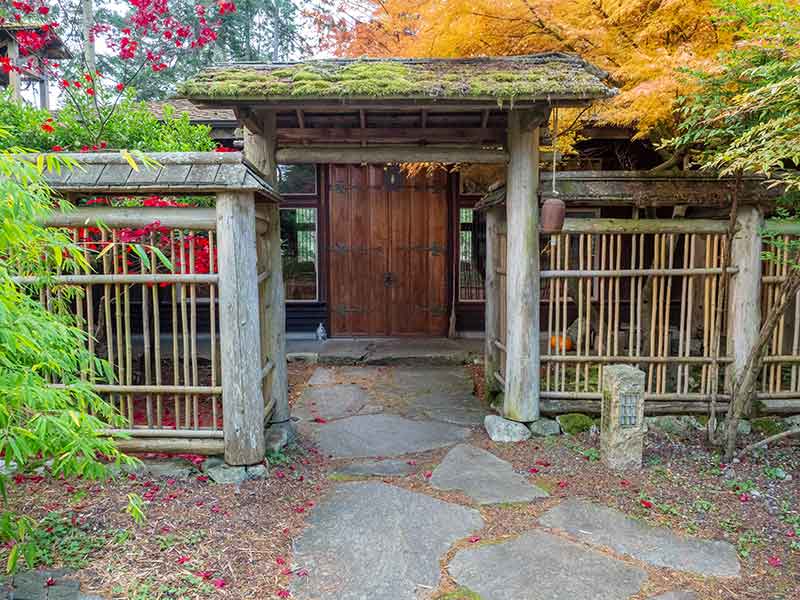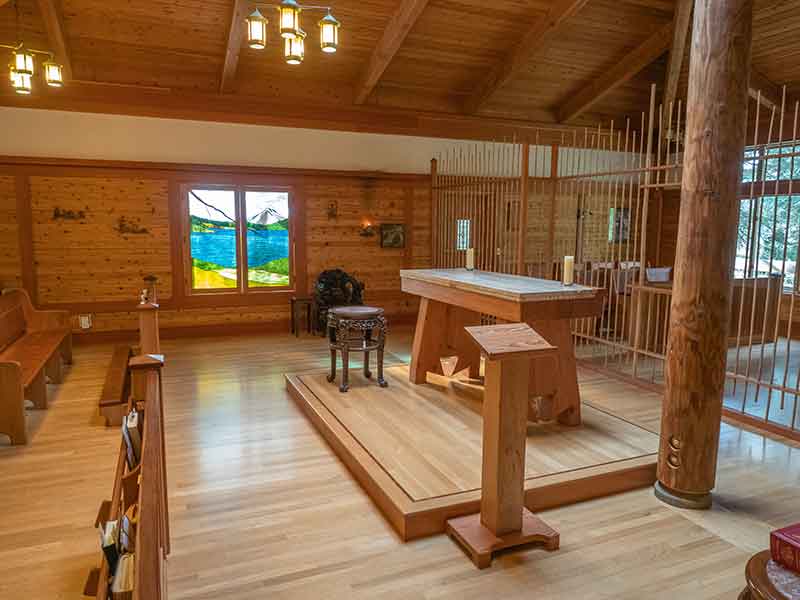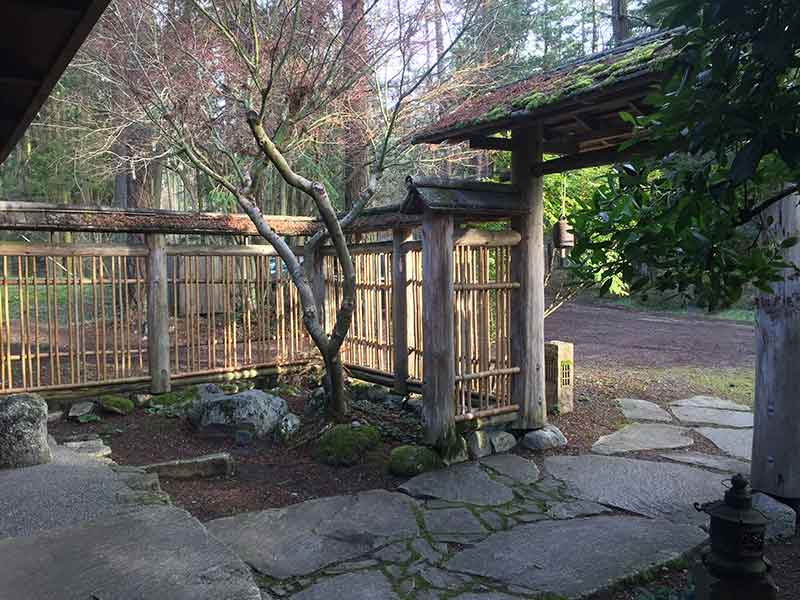PRAYER & LITURGY

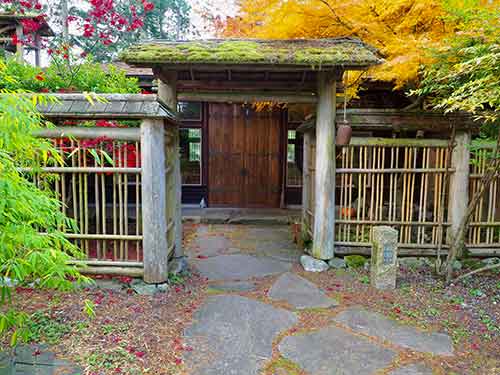
Shaw Island, the smallest of the San Juan Islands, is known for its rugged beauty, isolation, and perhaps most of all, its quiet. Our monastery provides visitors with a place and time for prayer and contemplation, especially within our chapel. Those who enter our chapel for the first time often gasp at its beauty and no matter their religious persuasion, find peace there that draws them to return again and again.
“Our Lady of Rock is a restorative place of silence and the Chapel there is the most centering place in the Pacific Northwest.” —Annual visitor to Shaw Island
History
The first building on the land where our monastery stands was a Utility Building, designed by architect Henry Klein, of Henry Klein Partnership in Mount Vernon, at the request of Mr. Henry Ellis. The Utility Building would become the footprint for the future chapel.
In the early 1970's Henry Ellis offered his land to Lady Abbess Benedict, O.S.B., Foundress and 1st Abbess of Regina Laudis to make a monastic foundation. When she first visited, the Utility Building was intact and the main monastery building had been added as well. The Utility Building included two covered parking spaces, a well pump house with a small interior space, and an exterior Japanese bath heated with wood. Separating the bathing area from the car park was a rectangular patch of bamboo that grew up toward a hole in the roof reflecting the shape of the planter below.
Shortly before the first nuns arrived in 1977 to permanently establish the Priory, the Utility Building burned down and remained only a concrete foundation for the next twenty years. This foundation area formed the arrival point and entry to the monastery as part of the enclosure. In about 1994, Mother Prioress Therese asked architect Joseph Giampietro to design a new chapel for the Priory community on the site of the original Utility Building.
“From the outside we see a broad sheltering roof, a forty foot square, rising up to a point at the center—On the inside we stand on a wood floor, over a firm foundation of concrete, which rests on solid native bedrock. Hence the name of the Priory, Our Lady of the Rock.”
—Architect Joseph Giampietro at the Dedication of the Chapel 1997
“As we look East, we see a contemplative Japanese garden taking form. As we look West we see the fields and barns of the Priory's daily work. ”
—Architect Joseph Giampietro
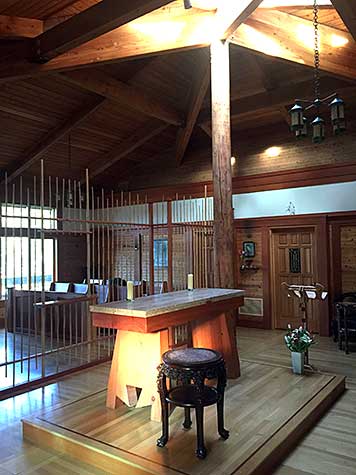
“Light, that transforms and changes the material we see, bursts in through an opening at the top. As we sit here in contemplation, our spirits can rise up though our limitations and be released into new dimensions of life. ” —Architect Joseph Giampietro
Dedication of the Chapel
The new chapel was dedicated on February 27, 1997. The Rt. Rev. Neal Roth O.S.B., Abbot of St. Martin's Abbey, Lacey, Washington, presided at the ceremony. In his homily he captured the purpose of this sacred space made possible by the generosity and gifts of so many:
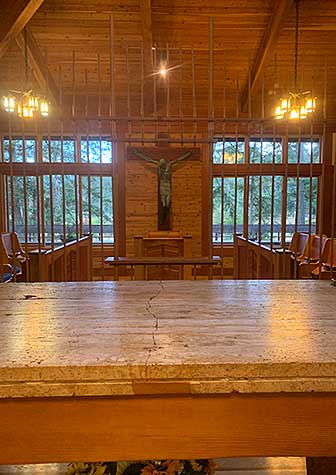
The Italian travertine stone slab, destined for a new altar at Our Lady of the Rock, was damaged after its arrival from Italy to the United States. The nuns had thought that Gordon Plume of G.R. Plume Company in Bellingham, who was building the altar, might try to conceal the large crack that ran across the center of the slab front to back. He offered a profound reflection as to why he chose to leave the crack showing front and center. He noted that if one stood in front of the altar and looked into the monastic choir, one would see that the crack in the slab was lined up directly with the sculpture of the Crucified Christ. For him this juxtaposition poignantly expressed what the Evangelists describe as the rending of the veil of the temple at the moment of Christ's death on the Cross:
Wood Used in the Building of the Chapel
A rich blend of various kinds of wood, sourced locally when possible, contribute to the warmth of the Chapel.
Exterior
Vertical siding: Our Lady of the Rock cedar, milled on Shaw Island
Horizontal: Douglas fir
Deck: Alaska yellow cedar
Door: Reclaimed old growth Douglas fir
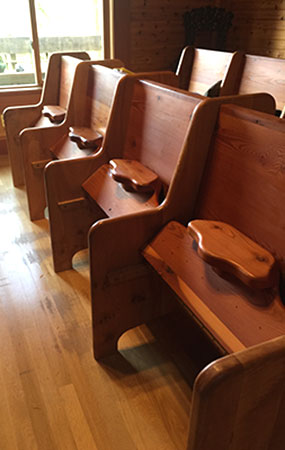 Interior
InteriorCeiling: Four large center-to-corner beams: glulams, Douglas fir
Other ceiling beams: Our Lady of the Rock Douglas fir, milled on Shaw Island
Car decking: Douglas fir
Walls: red cedar from British Columbia
trim: clear-grained fir
Center pole: Douglas fir
Floor: Eastern white oak
Altar: Italian travertine stone
Reclaimed old growth Douglas fir
Dark strip in platform: walnut
Grille: bamboo
Cross: cherry
Choir Stalls and Pews
Back: larch
Ends: Western maple
Front Panel: cherry
Caps: madrona
Sacristy
Cabinets: Eastern maple
Counter: reclaimed old growth Douglas fir
Artisans
The beauty of our monastic chapel was created through the collaborative work and craftsmanship of local artisans and professionals from Shaw and the other San Juan Islands. They are remembered and prayed for daily by the monastic community.
- Architect: Joseph Giampietro, Seattle
- Contractor: Ed Hopkins, Springtide Construction, Shaw Island
- Italian Travertine Stone for Altar: Abbey of Regina Laudis
- Corpus of Crucified Christ: Sculptress Frances Rich
- Heating: Dan Brown, Brown's Heating and Refrigeration, San Juan Island
- Tabernacle: Tim Cardinale, Anita Orne, Howard Shirley, Orcas Heating and Sheet Metal, Orcas Island
- Tabernacle Doors: Michele de Long, Orcas Island
- Electrical Work: Bill Dallas, Dallas Electric, Orcas Island
- Chapel, Garden Gate and Fence: Neal Foley, Shaw Island
- Sacristy Cabinets: Jeffrey George, Hayden Lake
- Stained Glass Window: Martha Hansen, Shaw Island
- Private Gardens: Japanese Garden: Susan and Jim Harrison, Bellingham
- Foundation Slab: Mike Hayworth, Hayworth Design and Construction, Orcas Island
- Milling, Setting Glulams: Henry Hoffman, Shaw Island
- Contractor's Assistant: Bret Hopkins, Shaw Island
- Chapel: Jeff and Kathy Hopkins, Springtide Construction, Shaw Island
- Finish Carpentry: Bruce King, White Beach Construction, Orcas Island
- Bronze Door Fixtures: John Keppleman, Bellingham
- Chapel, Woodshed: Monte Larsen, Shaw Island
- Lighting Consultant: Ted Lehn, Eureka Design, San Juan Island
- Exposed Aggregate: John Nopson, Upright Construction, Lopez Island
- Staining of Decks and Creation of Paths: Our Lady of the Rock Land Program Interns
- Chapel Ceiling: Bill Planansky, Murietta, CA
- Painting of Windows: Wilmer Planansky, Cayucos, CA
- Altar, Choir Grille, Entrance Doors, Counter Top in Sacristy: Gordon Plume, G.R. Plume Co., Bellingham
- Chapel Roof: Tim Riggins, Shaw Island
- Laying Italian Tile: Chris and Tim Schlosser, Dave, Portland
- Excavation, Rock Placement, Road: Hardy Schmidt, Shaw Island
- Electrical Work: Dan Schuman, Big D Electric, San Juan Island
- Finish Carpentry: Tim Simonian: Outland Construction, Orcas Island
- Plumbing: Bob Spring, Glocca Morra Plumbing and Heating, Orcas Island
- Drywall: Jim Stivason, Stivason Drywall, Mt. Vernon
- Floors, Altar Platform, Pews, Choir Stalls, Cross: Rick Waldron: Sound Products, San Juan Island
- Staining of Decks: Justin White
Our Chapel Has a New Roof!
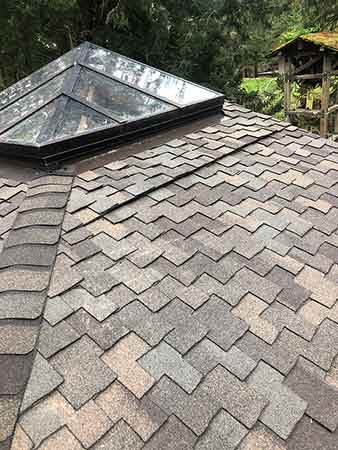 October saw the restoration of our chapel roof by Mt. Baker Roofing Inc. of Bellingham. The roof had been leaking over the last couple of years with water staining the wall above our tabernacle and creating small puddles on the beautiful wooden floors. The new 50-year composition roof and vented assembly for air flow will protect the chapel from moisture and decay. This renovation project affirms the commitment of our community to build the future and to the continuity of praise in this sacred space for generations to come. We look forward, in hope, to seeing you again in our chapel.
October saw the restoration of our chapel roof by Mt. Baker Roofing Inc. of Bellingham. The roof had been leaking over the last couple of years with water staining the wall above our tabernacle and creating small puddles on the beautiful wooden floors. The new 50-year composition roof and vented assembly for air flow will protect the chapel from moisture and decay. This renovation project affirms the commitment of our community to build the future and to the continuity of praise in this sacred space for generations to come. We look forward, in hope, to seeing you again in our chapel. Thank you for your generosity that made the chapel roof restoration possible!
Until you are able to visit our chapel in person and pray in this sacred space, please enjoy this gallery. (Click to enlarge.)
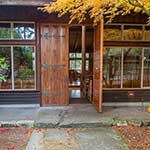 |
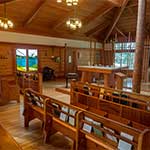 |
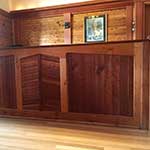 |
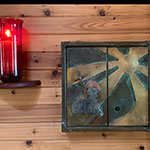 |
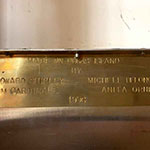 |
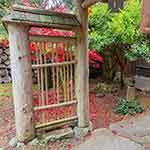 |
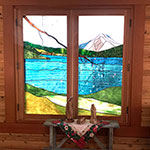 |
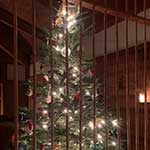 |
